Color and Light: A Hellenistic Terracotta Figurine of a Maenad from Myrina
Abstract
1. Introduction
2. Materials and Methods
2.1. Presentation of the Maenad from Myrina (Athens, National Archaeological Museum, inv. 5000)
Condition of the Figurine
2.2. Scientific Study of the Polychromy: Methodology
2.2.1. Imaging
2.2.2. Digital Microscopy
2.2.3. X-ray Fluorescence Spectroscopy (XRF)
2.2.4. Fourier-Transform Infrared Spectroscopy (FTIR)
2.2.5. Fibre Optics Reflectance and Fluorescence Spectroscopy
3. Results
3.1. Preparation Layer
3.2. Flesh Tones and Facial Features
3.3. Hair and Headdress
3.4. Dress
3.5. Nebris
3.6. Gilded Highlights
4. Discussion: Modeling with Color and Light
5. Conclusions
Supplementary Materials
Author Contributions
Funding
Data Availability Statement
Acknowledgments
Conflicts of Interest
References
- Bremmer, J.; Maenads, N. The Oxford Classical Dictionary, 3rd ed.; Oxford University Press: Oxford, UK, 2005; 194p. [Google Scholar]
- Pasquier, A.; Martinez, J.-L. (Eds.) Praxitèle; Musée du Louvre, Somogy: Paris, France, 2007; 40p. [Google Scholar]
- Stewart, A. Greek Sculpture. An Exploration; Yale University Press: New Haven, CT, USA; London, UK, 1990; 177p. [Google Scholar]
- Rolley, C. La Sculpture Grecque. 2. La Période Classique; Picard: Paris, France, 1999; pp. 272–273. [Google Scholar]
- Jeammet, V. (Ed.) Tanagras. Figurines for Life and Eternity; (Lady Pozzi) and 255 cat. 207 (Lady Baillehache) cat.117; Fondation Bancaja: Valencia, Spain, 2010; pp. 156–157. [Google Scholar]
- Bouquillon, A.; Zink, A.; Porto, E. Les Tanagras du Louvre à la lumière des analyses scientifiques. Authenticité, Matières. In Tanagras. De l’objet de Collection à l’objet Archéologique; Jeammet, V., Ed.; Musée du Louvre: Paris, France, 2007; pp. 91–99. [Google Scholar]
- Bourgeois, B.; Jeammet, V. Peindre et repeindre sur terre cuite en Grèce hellénistique. In Thérapéia. Polychromie et Restauration de la Sculpture dans l’Antiquité, Technè; Bourgeois, B., Ed.; Centre de Recherche et de Restauration des Musées de France: Paris, France, 2014; Volume 40, pp. 84–95. [Google Scholar]
- Bourgeois, B.; Jeammet, V. La polychromie des terres cuites grecques: Approche matérielle d’une culture picturale. Revue Archéologique 2020, 1, 3–29. [Google Scholar] [CrossRef]
- Philadelpheus, A. Πήλινα ειδώλια εκ Μυρίνης: Συλλογή Ι. Μισθού εν τω Εθνικώ Μουσείω Aθηνών; Eleutheroudakis: Athens, Greece, 1928; 19p. [Google Scholar]
- Winter, F. Die Typen der Figürlichen Terrakotten II; Berlin, Germany; Stuttgart, Germany, 1903; Volume 66. [Google Scholar]
- Pottier, E.; Reinach, S. La nécropole de Myrina: Recherches Archéologiques Exécutées au nom et aux Frais de L’école Française d’Athènes par; Pottier, E., Reinach, S., Veyries, A., Eds.; Ernest Thorin: Paris, France, 1887. [Google Scholar]
- Kassab, D. La petite plastique de Myrina inspirée de la grande plastique de Pergame. Topoi 2016, 285–302. [Google Scholar]
- Besques, S.; Musée national du Louvre. Catalogue raisonné des figurines et reliefs en terre-cuite grecs, étrusques et romains. III. In Epoques Hellénistique et Romaine. Grèce et Asie Mineure; RMN: Paris, France, 1972. [Google Scholar]
- Duchêne, H.; Mathieux, N. La lettre et l’argile. Autour d’une Semaine de Fouilles à Myrina; Universitaires de Dijon: Dijon, France, 2007. [Google Scholar]
- Drilhon, F.; Gautier, J.; Lahanier, C. Étude de quelques figurines de terre cuite de Myrina, Revue d’Archéométrie, n°1, 1981. In Proceedings of the Actes du XXe Symposium International D’archéométrie Paris, Paris, France, 26–29 March 1980; Volume III, pp. 73–82. [Google Scholar] [CrossRef]
- Calamiotou, M.; Filippakis, S.E.; Jones, R.E.; Kassab, D. Spectrographic Analyses of Terracotta Figurines from Myrina: An Attempt to Characterize Workshops. J. Archaeol. Sci. 1984, 11, 103–117. [Google Scholar] [CrossRef]
- Karouzou, S. Collection des Sculptures, Catalogue Descriptive; Athènes, Musée National: Athènes, Greece, 1967. [Google Scholar]
- Abbe, M. A Roman Marble Replica of the «South Slope Head»: Polychromy and Identification. Source Notes Hist. Art 2011, 30, 18–24. [Google Scholar] [CrossRef]
- Bourgeois, B.; Jeammet, V.; Verri, G. La main du peintre: Découvertes sur la polychromie des statuettes en terre cuite grecques. In Archéologia Hors série n° 27, Les Ecoles Françaises à l’Etranger; 2019; pp. 6–11. [Google Scholar]
- Miliani, C.; Rosi, F.; Daveri, A.; Brunetti, B.G. Reflection infrared spectroscopy for the non-invasive in situ study of artists’ pigments. Appl. Phys. A 2012, 106, 295–307. [Google Scholar] [CrossRef]
- Rosi, F.; Daveri, A.; Doherty, B.; Nazzareni, S.; Brunetti, B.G.; Sgamellotti, A.; Miliani, C. On the use of overtone and combination bands for the analysis of the CaSO4-H2O system by mid-infrared reflection spectroscopy. Appl. Spectrosc. 2010, 64, 956–963. [Google Scholar] [CrossRef] [PubMed]
- Aceto, M.; Agostino, A.; Fenoglio, G.; Idone, A.; Gulmini, M.; Picollo, M.; Ricciardi, P.; Delaney, J.K. Characterisation of colourants on illuminated manuscripts by portable fibre optic UV-visible-NIR reflectance spectrophotometry. Anal. Methods 2014, 6, 1488–1500. [Google Scholar] [CrossRef]
- Morris, R.V.; Lauer, H.V., Jr.; Lawson, C.A.; Gibson, E.K., Jr.; Nace, G.A.; Stewart, C. Spectral and other physicochemical properties of submicron powders of hematite (alpha-Fe2O3), maghemite (gamma-Fe2O3), magnetite (Fe3O4), goethite (alpha-FeOOH), and lepidocrocite (gamma-FeOOH). J. Geophys. Res. 1985, 90, 3126–3144. [Google Scholar] [CrossRef] [PubMed]
- Verri, G. The spatially resolved characterisation of Egyptian blue, Han blue and Han purple by photo-induced luminescence digital imaging. Anal. Bioanal. Chem. 2009, 394, 1011–1021. [Google Scholar] [CrossRef] [PubMed]
- Jeammet, V.; Knecht, C.; Pagès-Camagna, S. La couleur sur les terres cuites hellénistiques: Les figurines de Tanagra et de Myrina dans la collection du musée du Louvre. In Peinture et Couleur Dans le Monde Grec Antique; Descamps-Lequime, S., Ed.; Louvre, 5 Continents: Paris, France, 2007; pp. 192–203. [Google Scholar]
- Fonseca, B.; Schmidt Patterson, C.; Ganio, M.; MacLennan, D.; Trentelman, K. Seeing red: Towards an improved protocol for the identification of madder- and cochineal-based pigments by fiber optics reflectance spectroscopy (FORS). Herit. Sci. 2019, 7, 92. [Google Scholar] [CrossRef]
- Bisulca, C.; Picollo, M.; Bacci, M.; Kunzelman, D. UV-Vis-NIR reflectance spectroscopy of red lakes in paintings. In Proceedings of the 9th International Conference on Non-Destructive Testing of Art, Jerusalem, Israel, 25–30 May 2008; pp. 1–8. [Google Scholar]
- René de la Rie, E. Fluorescence of paint and varnish layers (Part I). Stud. Conserv. 1982, 27, 1–7. [Google Scholar]
- Daniels, V.; Deviese Th Hacke, M.; Higgitt, C. Technological Insights into Madder Pigment Production in Antiquity; British Museum Technical Bulletin hal-03207945; The British Museum: London, UK, 2014; Volume 8, pp. 13–28. [Google Scholar]
- Farnsworth, M.; Second Century, B.C. Rose Madder from Corinth and Athens. Am. J. Archaeol. 1951, 55, 236–239. [Google Scholar] [CrossRef]
- Delaney, J.K.; Dooley, K.A.; Radpour, R.; Kakoulli, I. Macroscale multimodal imaging reveals ancient painting production technology and the vogue in Greco-Roman Egypt. Sci. Rep. 2017, 7, 15509. [Google Scholar] [CrossRef] [PubMed]
- Hofmann, C.; Rabitsch, S.; Malissa, A.; Aceto, M.; Uhlir, K.; Griesser, M.; Calà, E.; Agostino, A.; Fenoglio, G. The miniatures of the Vienna Genesis: Colour identification and painters’ palette. In The Vienna Genesis: Material Analysis and Conservation of a Late Antique Illuminated Manuscript on Purple Parchment 2020; Hofmann, C., Ed.; Böhlau Verlag: Wien, Austria; Köln, Germany; Weimar, Germany, 2020. [Google Scholar]
- Vezin, J.; Roger, P. Etude des matériaux de la couleur dans les manuscrits médiévaux: Emploi inédit de bleu égyptien dans trois manuscrits des VIIIe et Xe siècles. Comptes Rendus Des Séances De L’académie Des Inscr. Et Belles-Lett. 2007, 151, 67–87. [Google Scholar] [CrossRef]
- Van der Snickt, G.; Miliani, C.; Janssens, K.; Brunetti, B.; Romani, A.; Rosi, F.; Walter, P.; Castaing, J.; De Nolf, W.; Klaassen, L.; et al. Material analyses of ‘Christ with singing and music-making Angels’, a late 15th-century panel painting attributed to Hans Memling and assistants: Part I. non-invasive in situ investigations. J. Anal. At. Spectrom. 2011, 26, 2216–2229. [Google Scholar] [CrossRef]
- Bourgeois, B.; Jockey, P.h.; Karydas, A. New researches on Polychrome Hellenistic Sculpture in Delos—III: The Gilding Processes. Observations and Meanings. In Leukos Lithos. Marbres et Autres Roches de la Méditerranée Antique: Études Interdisciplinaires; Jockey, P., Ed.; ASMOSIA VIII: Paris, France, 2009; pp. 645–661. [Google Scholar]
- Fourdrin, C.; Pagès-Camagna, S.; Pacheco, C.; Radepont, M.; Lemasson, Q.; Moignard, B.; Pichon, L.; Bourgeois, B.; Jeammet, V. Characterization of gold leaves on Greek terracotta figurines: A PIXE-RBS study. Microchem. J. 2016, 126, 446–453. [Google Scholar] [CrossRef]
- Pagès-Camagna, S. Dorure et traitement de surface. In D’Izmir à Smyrne. Découverte d’une cité Antique; Hasselin-Rous, I., Laugier, L., Martinez, J.-L., Eds.; Louvre/Somogy: Paris, France, 2009; pp. 122–125. [Google Scholar]
- Bourgeois, B.; Jeammet, V.; Pagès-Camagna, S. «Color Siderum». La dorure des figurines en terre cuite grecques aux époques hellénistique et romaine. Bull. De Corresp. Hellénique 2013, 136–137, 483–510. [Google Scholar] [CrossRef]
- Rouveret, A. La couleur retrouvée. Découvertes de Macédoine et textes antiques. In Peinture et Couleur Dans le Monde Grec Antique; Descamps-Lequime, S., Ed.; Louvre, 5 Continents: Paris, France, 2007; pp. 68–79. [Google Scholar]
- Brecoulaki, H. Sur la techné de la peinture grecque ancienne d’après les monuments funéraires de Macédoine. Bull. Corresp. Hellénique 2000, 124, 189–216. [Google Scholar] [CrossRef]
- Dyer, J.; Sotiropoulou, S. A technical step forward in the integration of visible-induced luminescence imaging methods for the study of ancient polychromy. Herit. Sci. 2017, 5, 24. [Google Scholar] [CrossRef]
- Ierodiakonou, K. Empedocles and the Ancient Painters. In Colour in the Ancient Mediterranean World; Cleland, L., Stears, K., Eds.; International Series; BAR Publishing: Oxford, UK, 2004; Volume 1267, pp. 91–95. [Google Scholar]
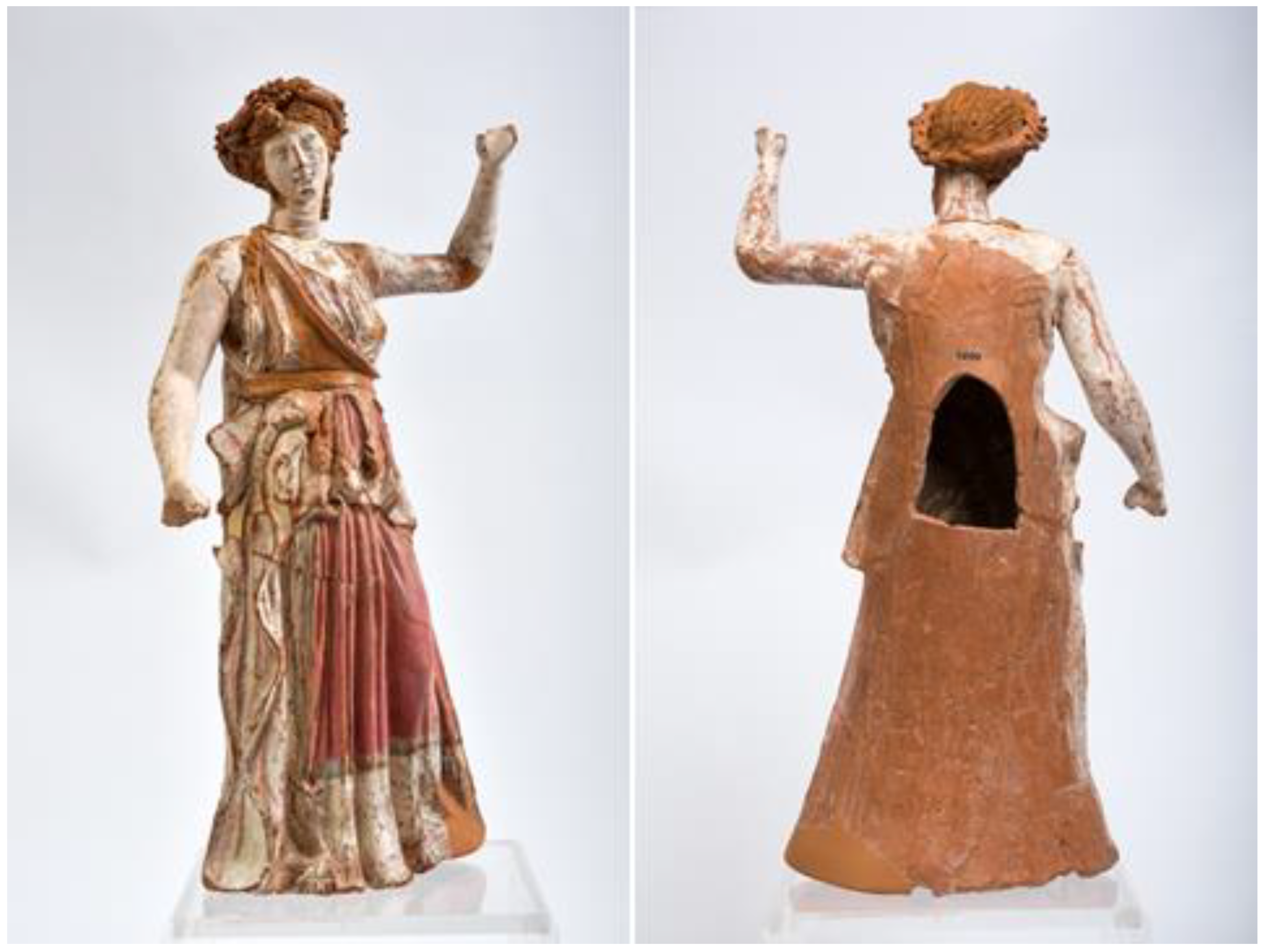
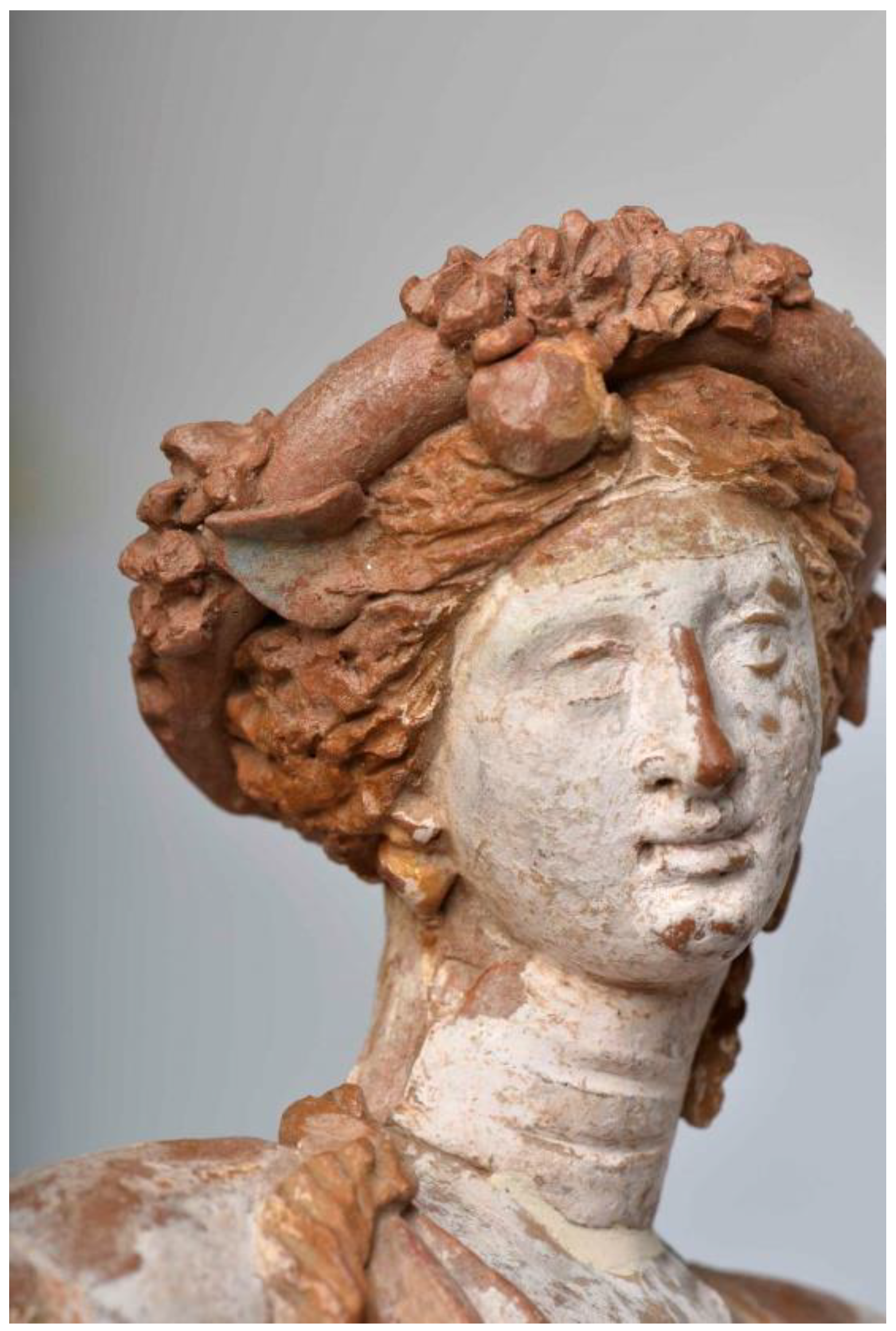
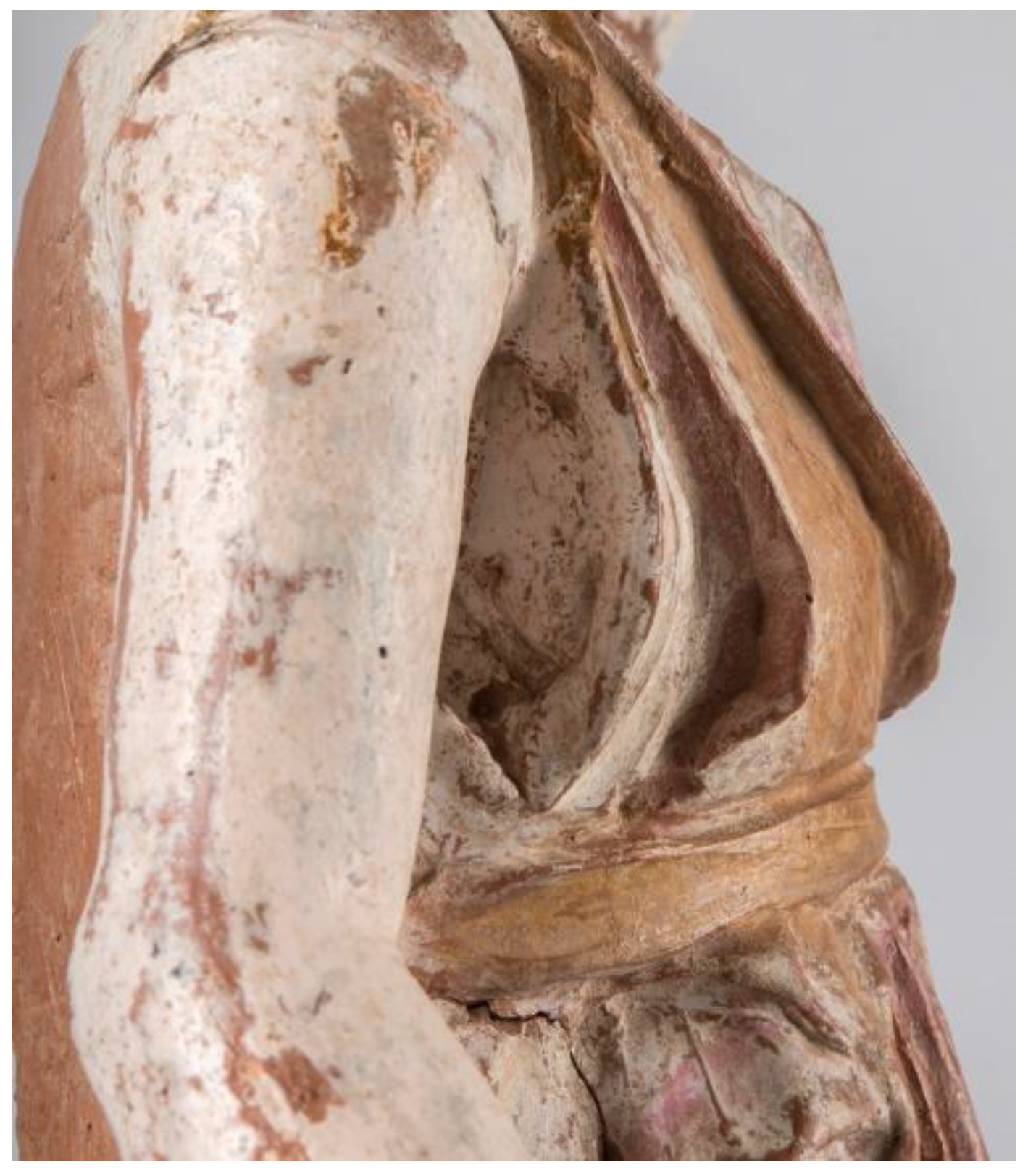
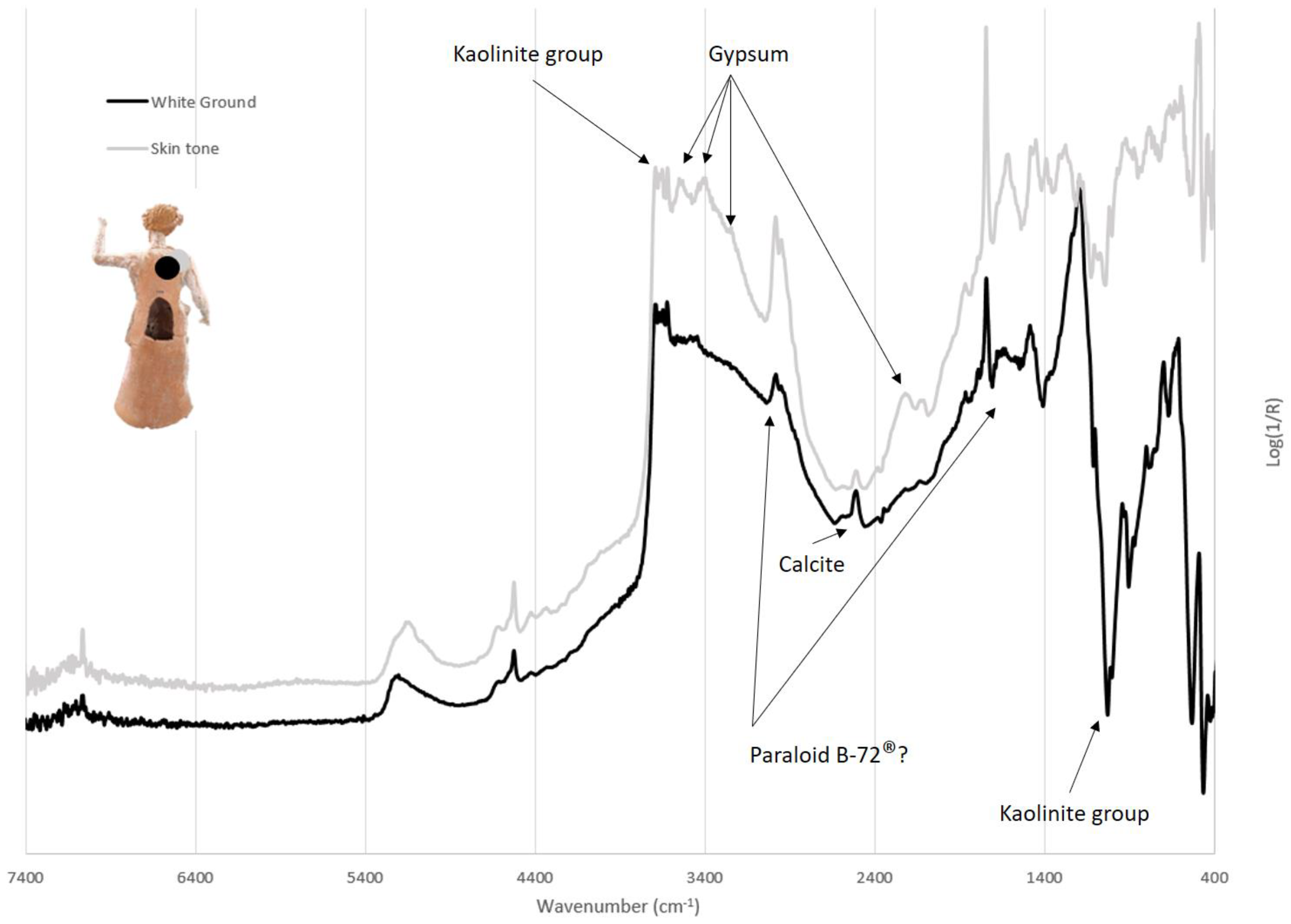
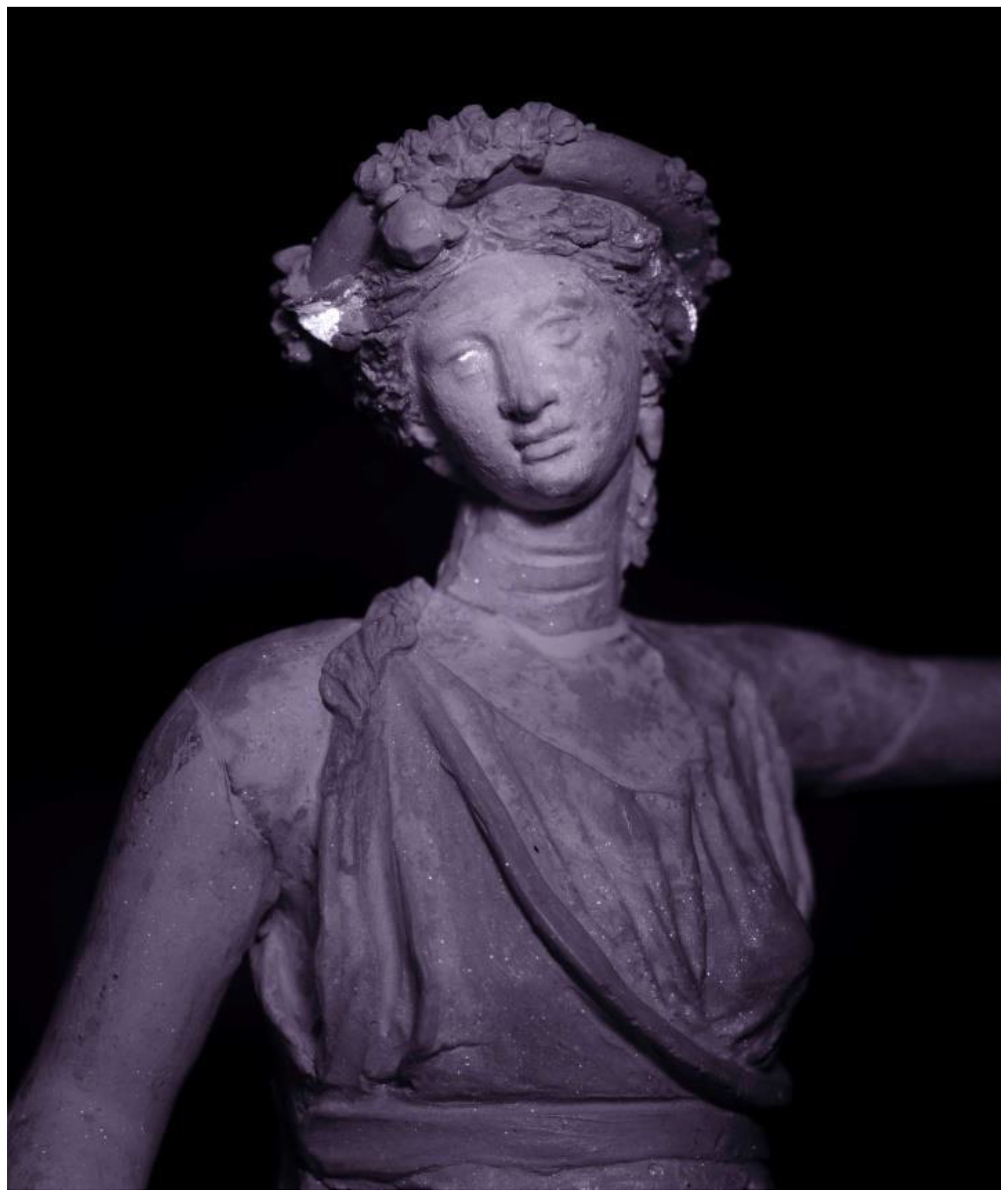
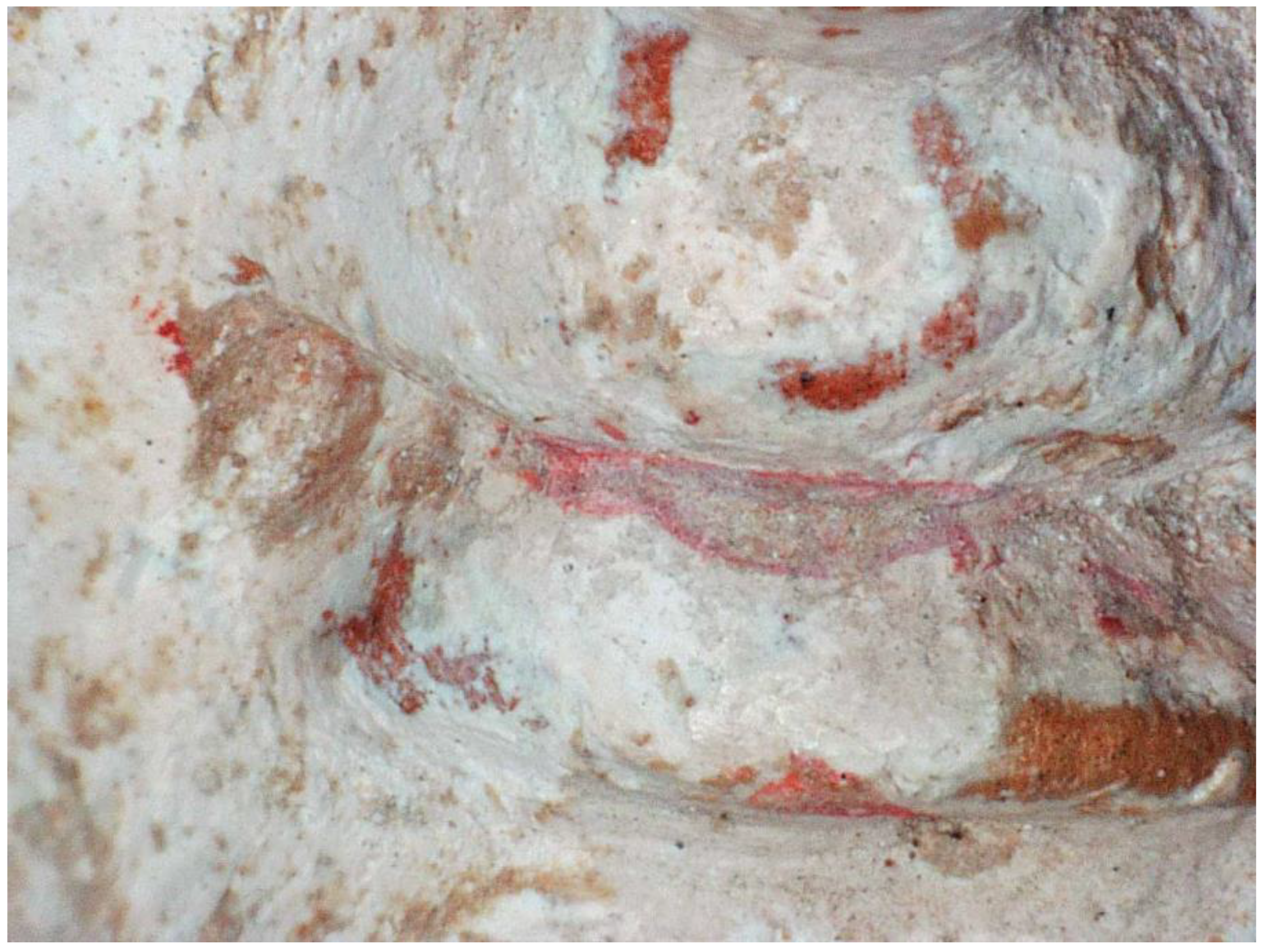
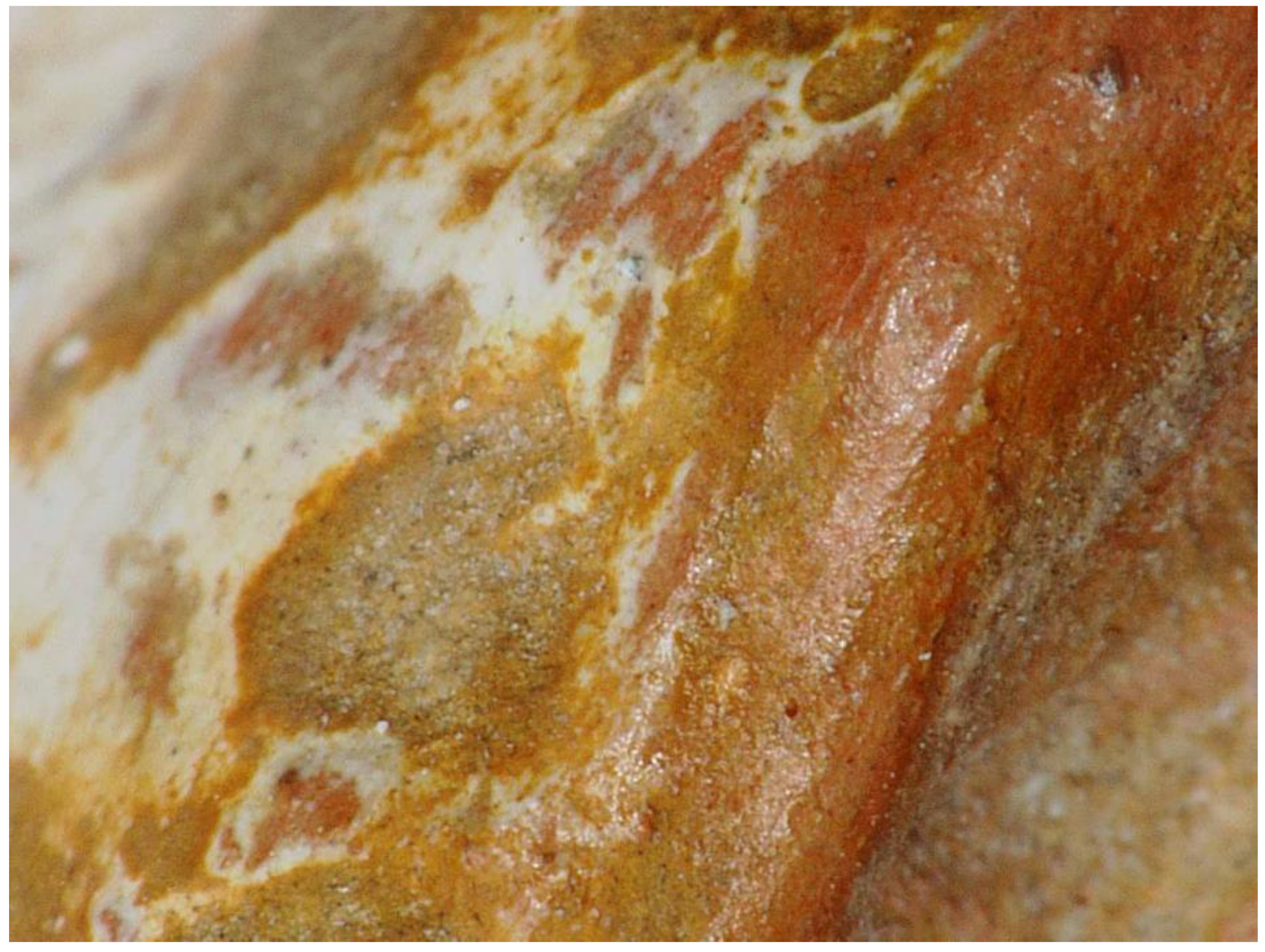
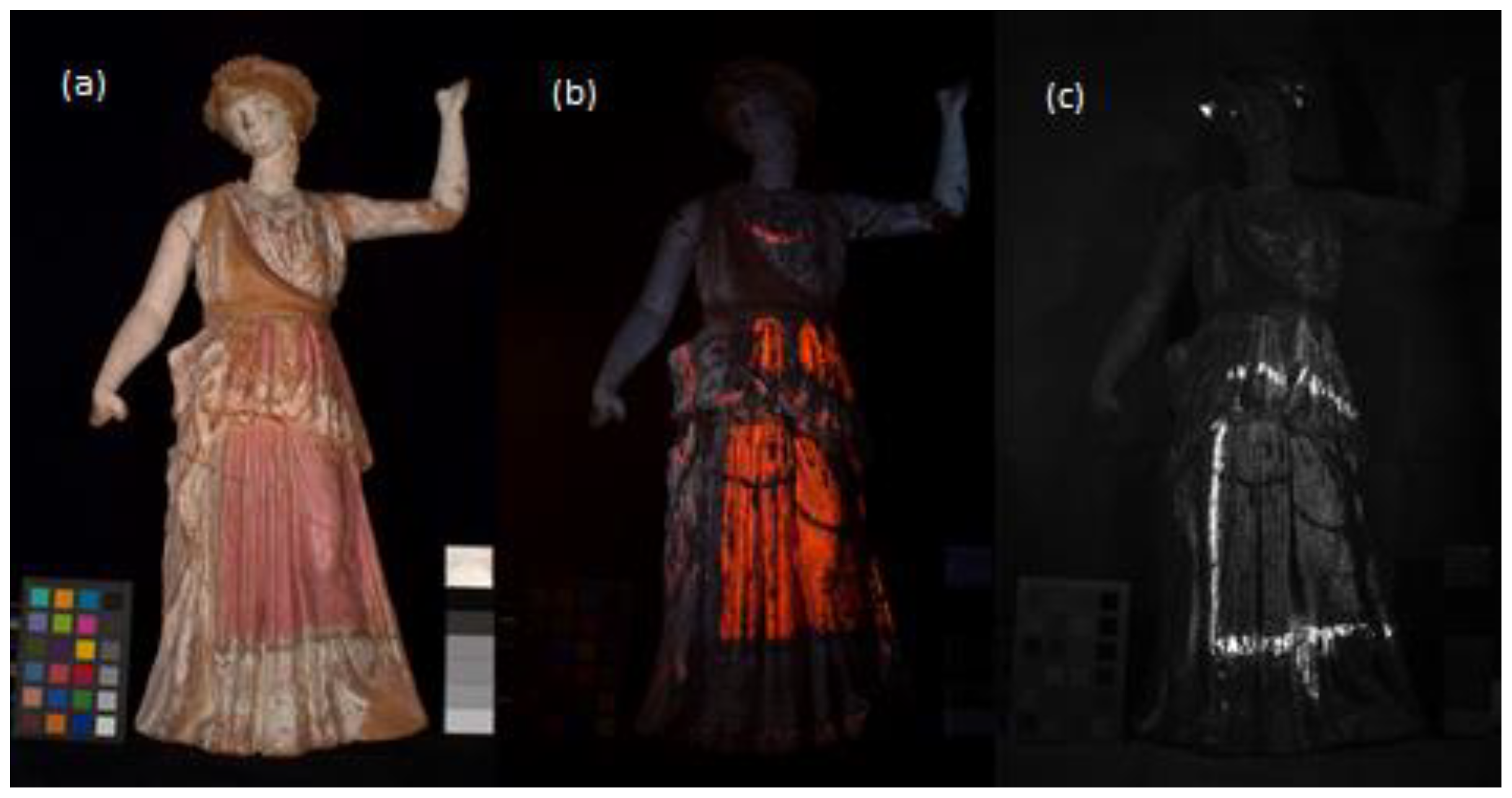
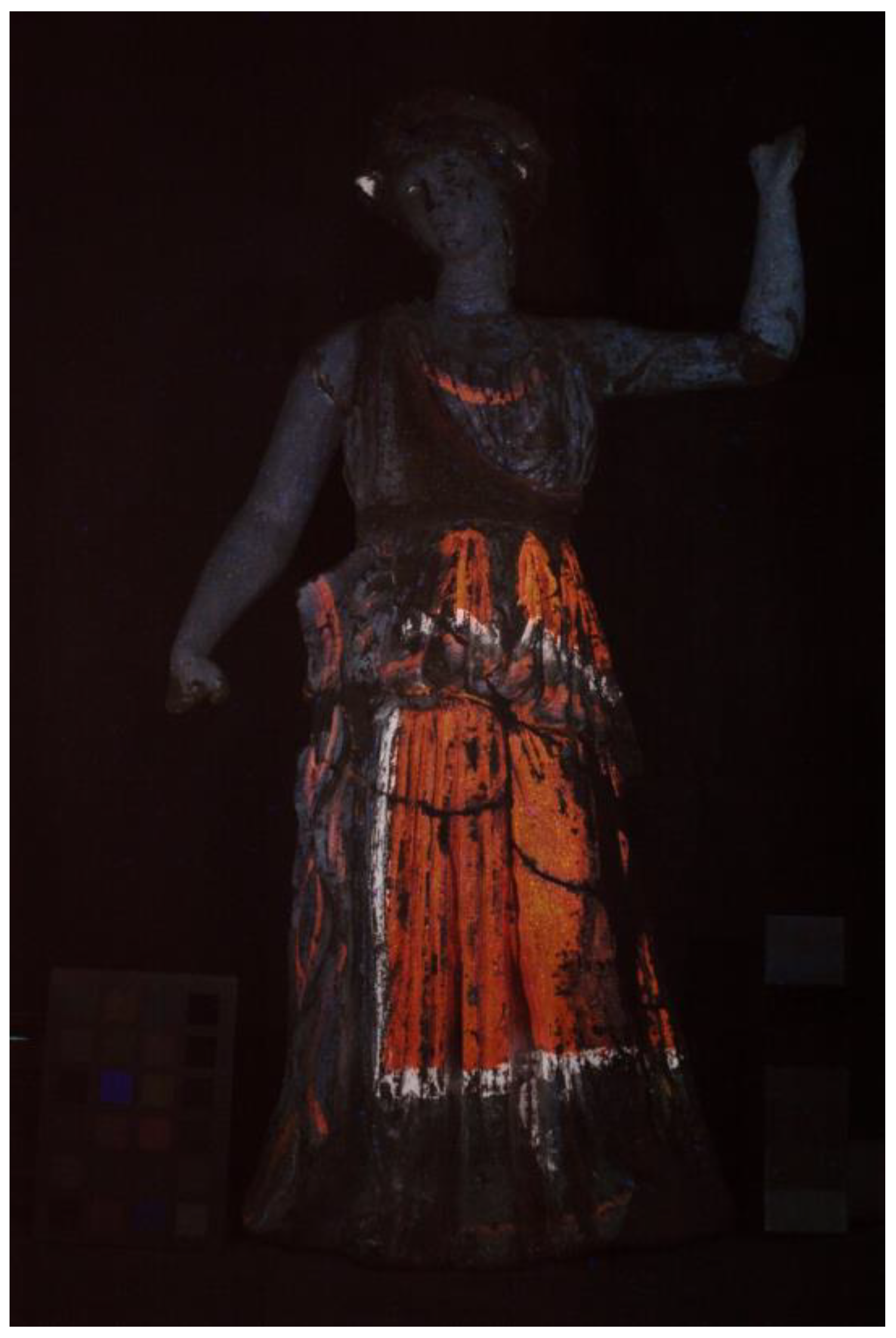
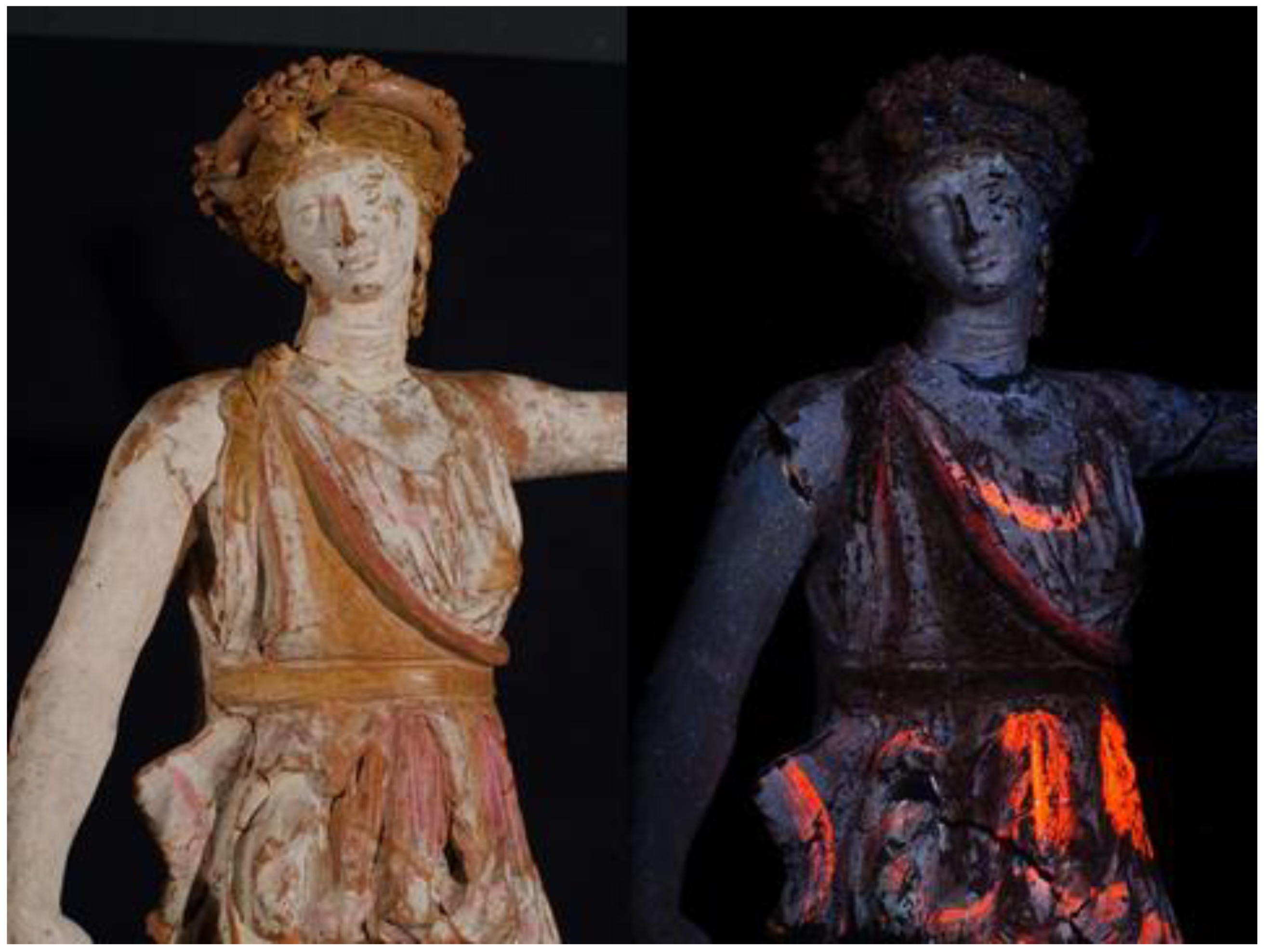
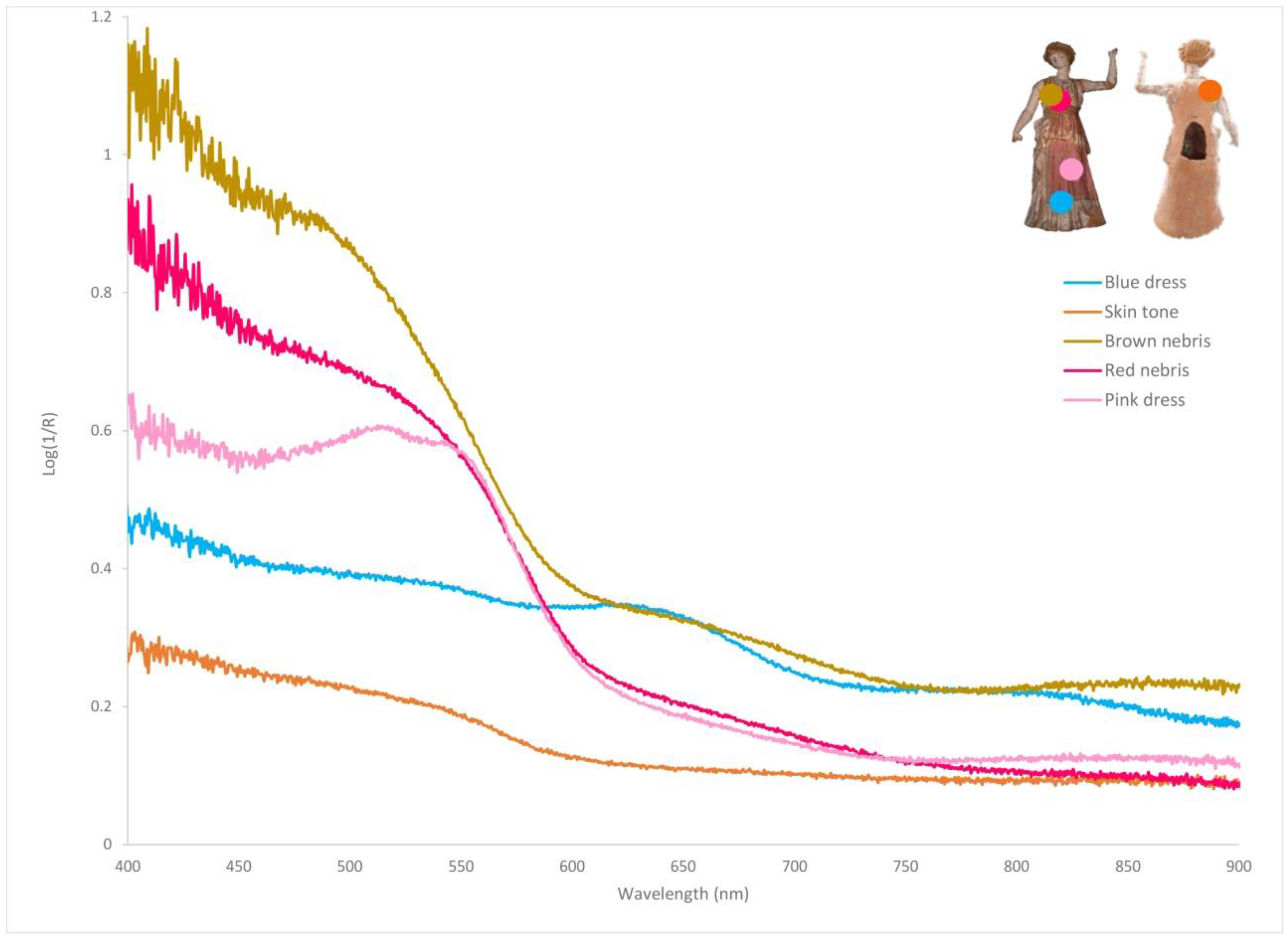
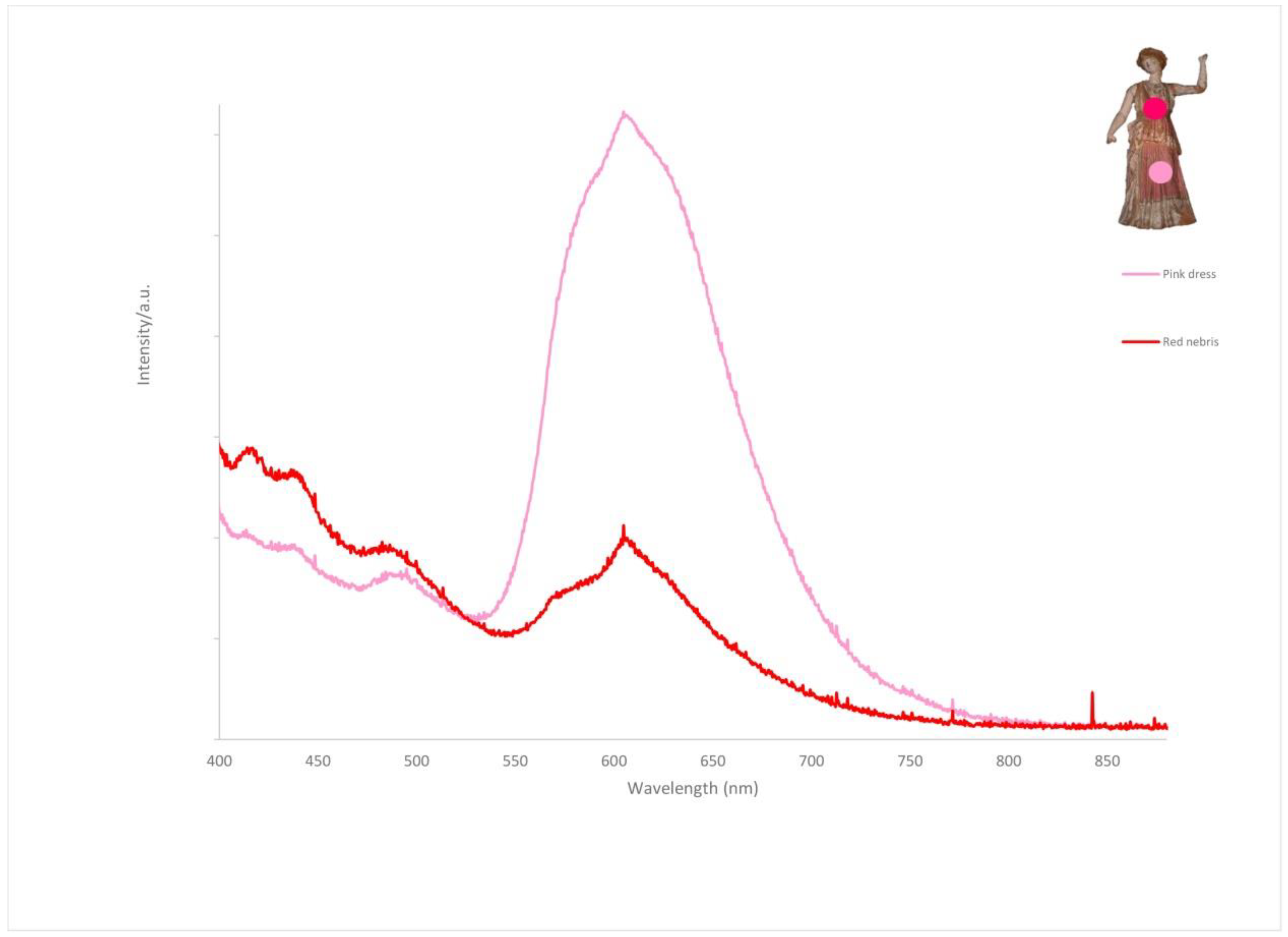
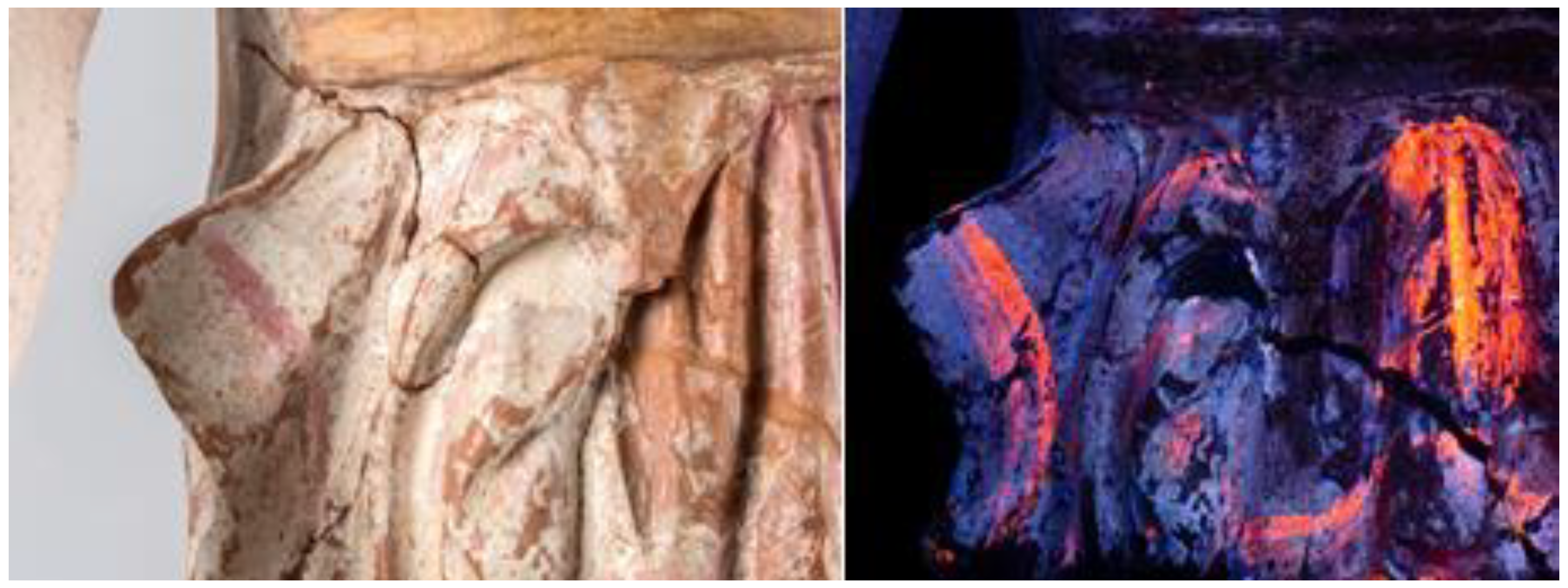
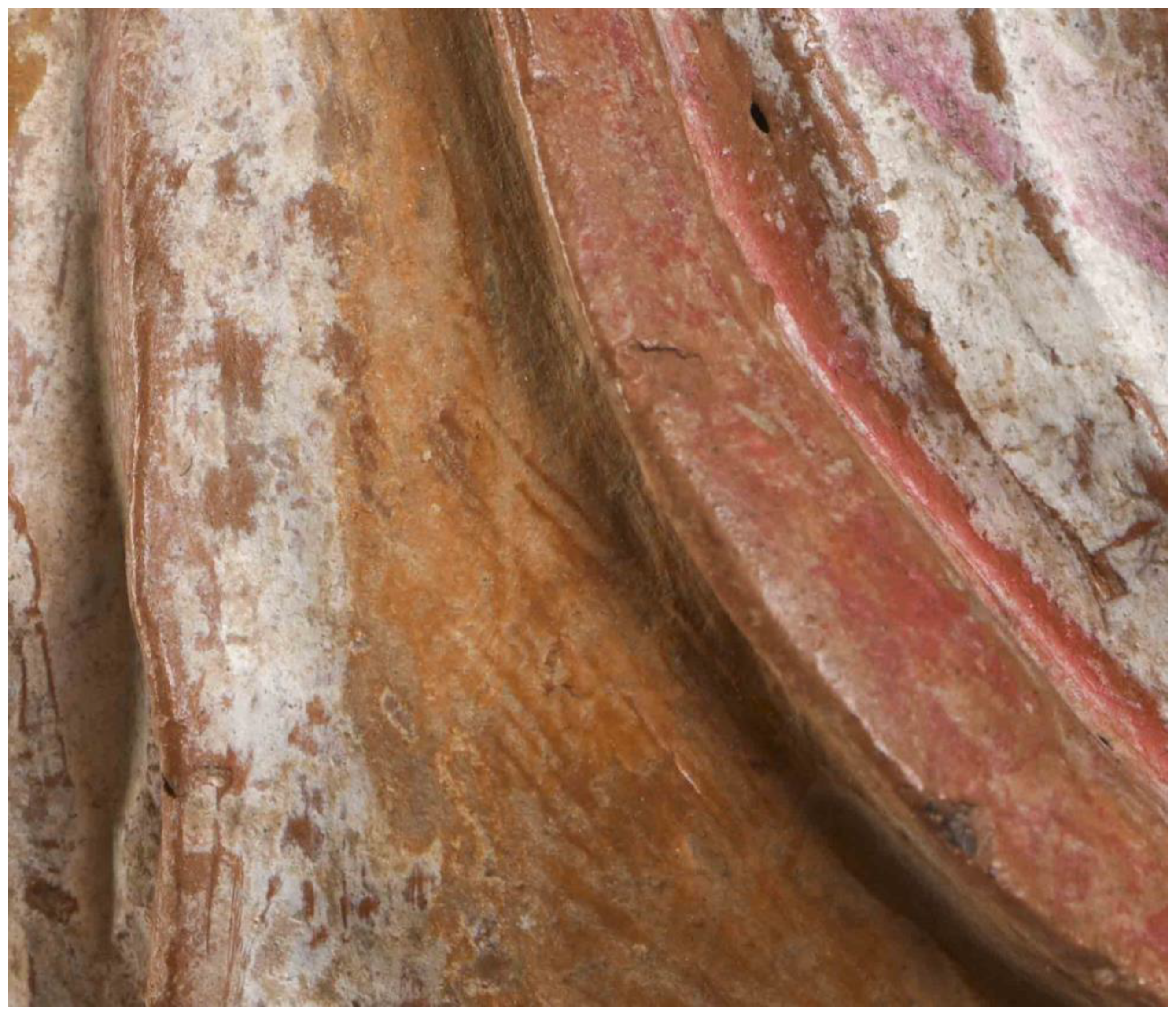
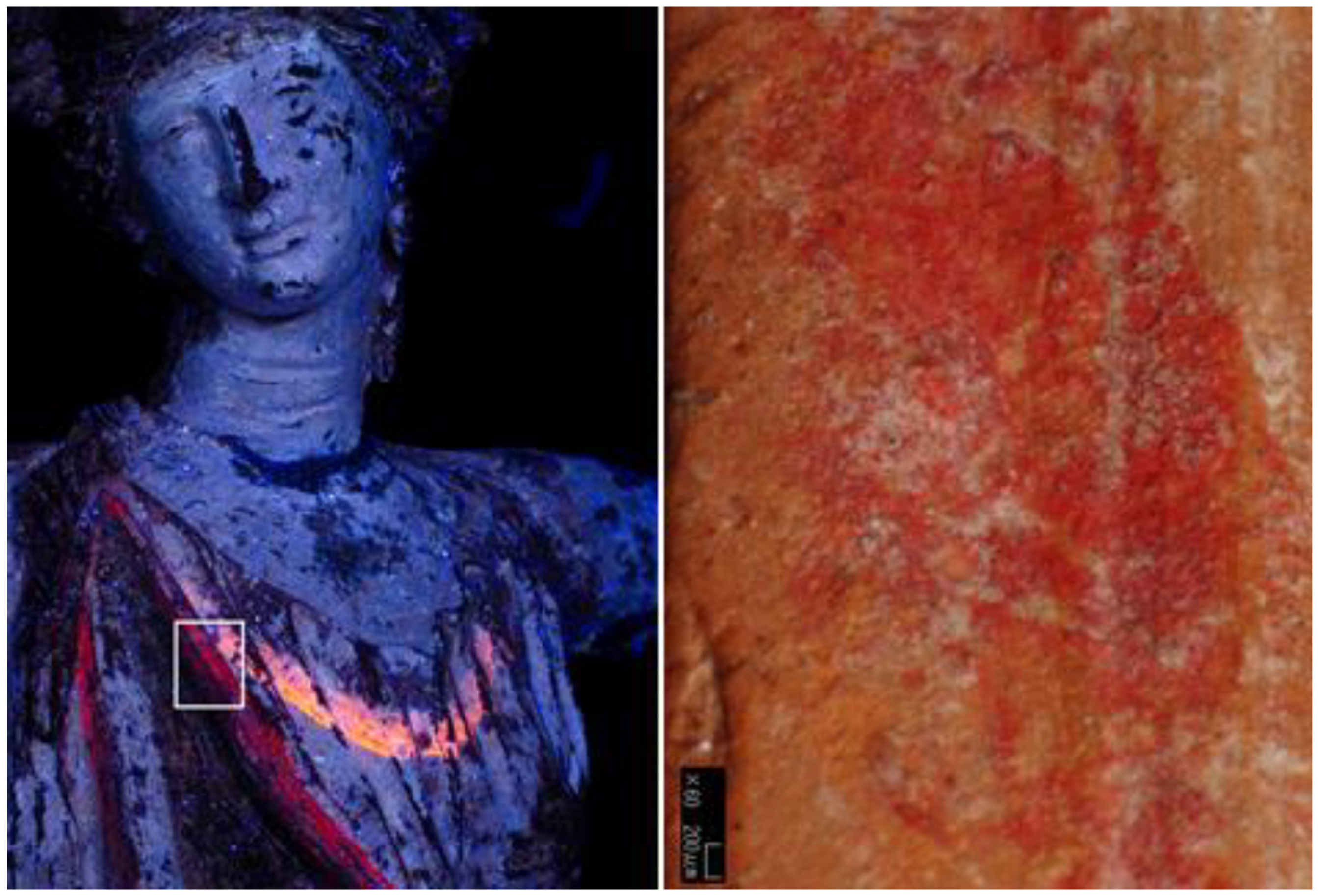
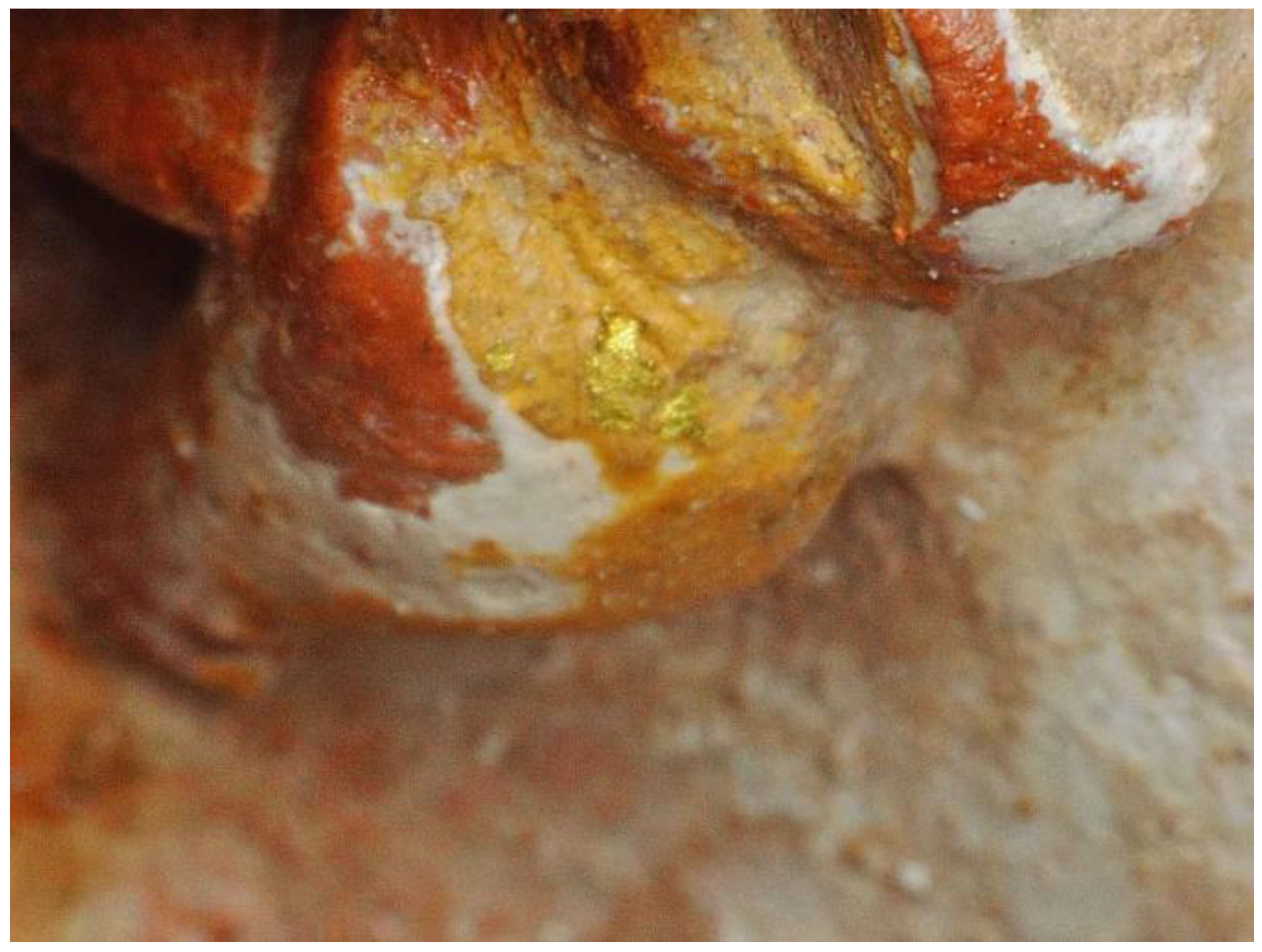
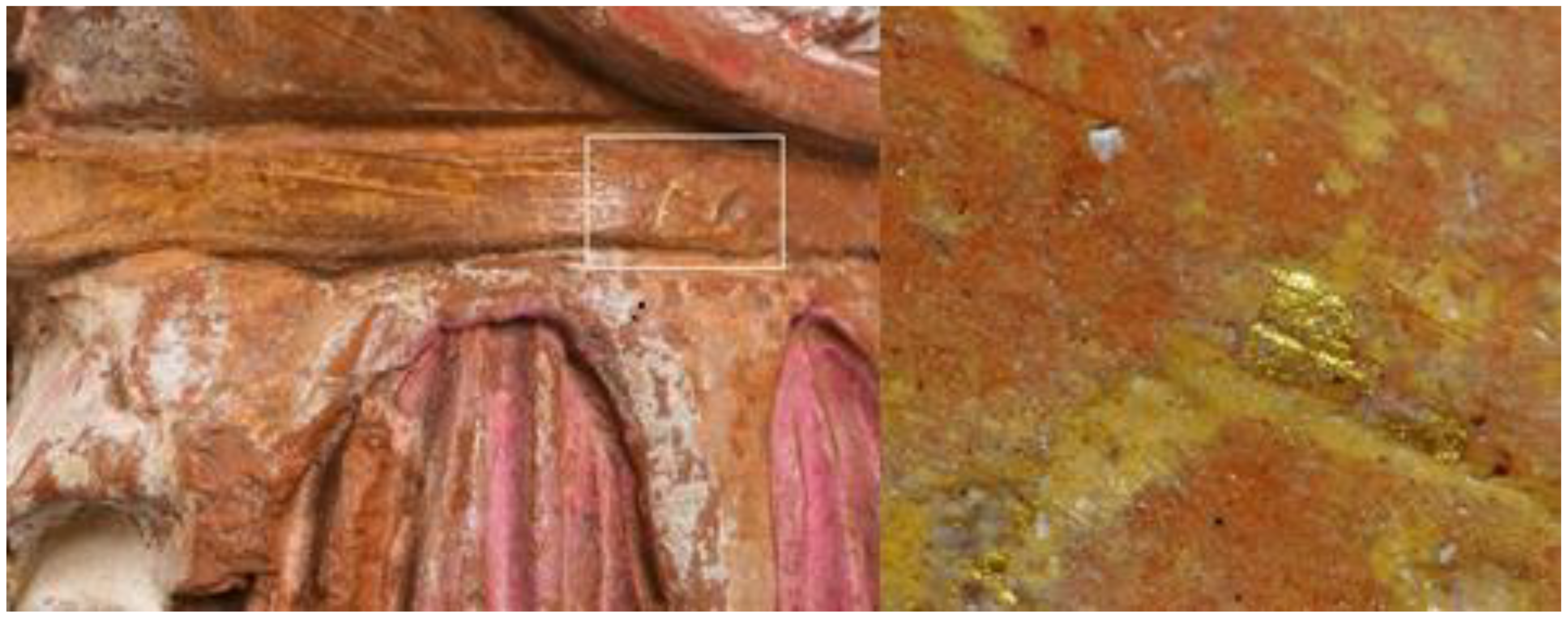
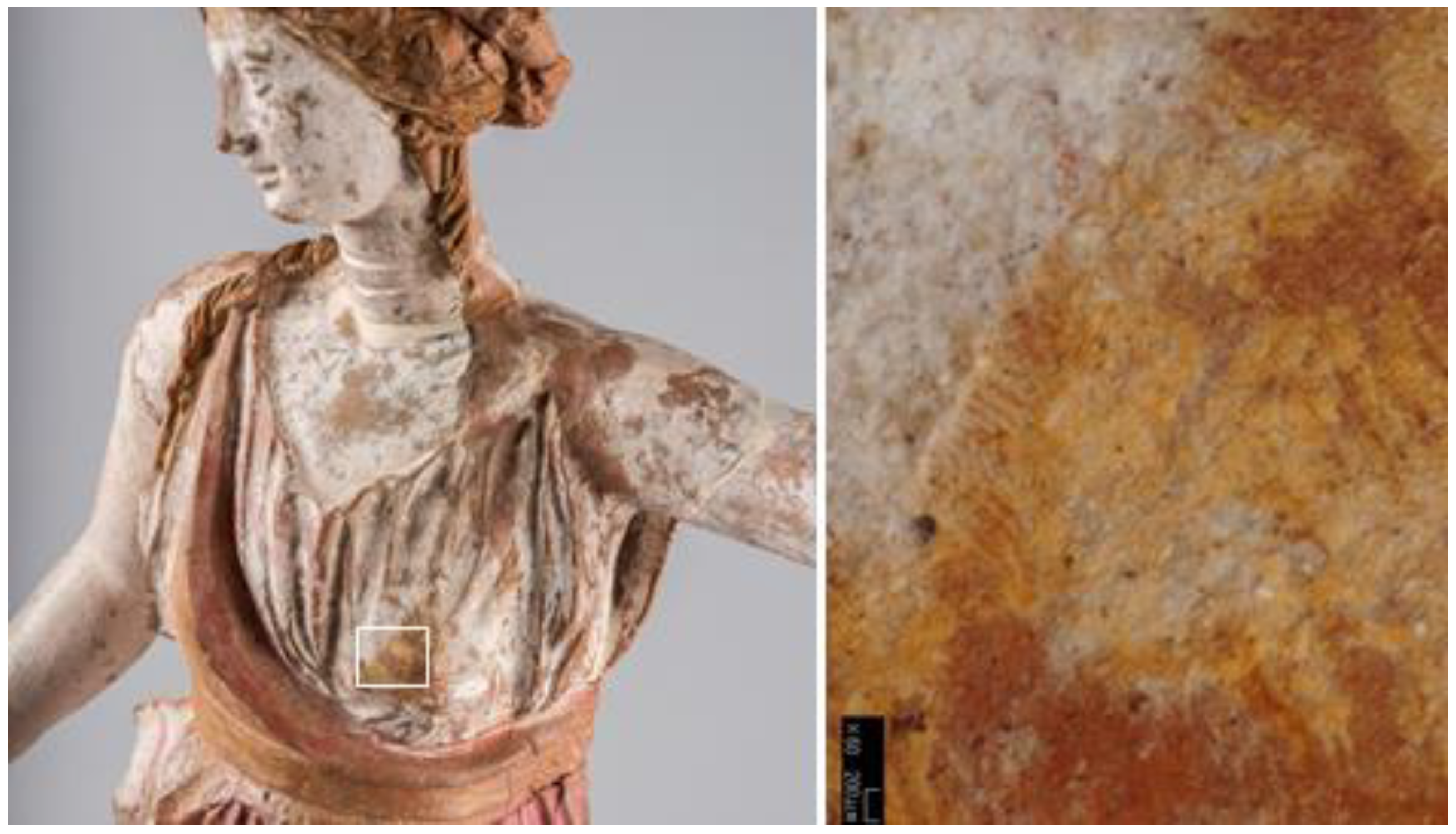
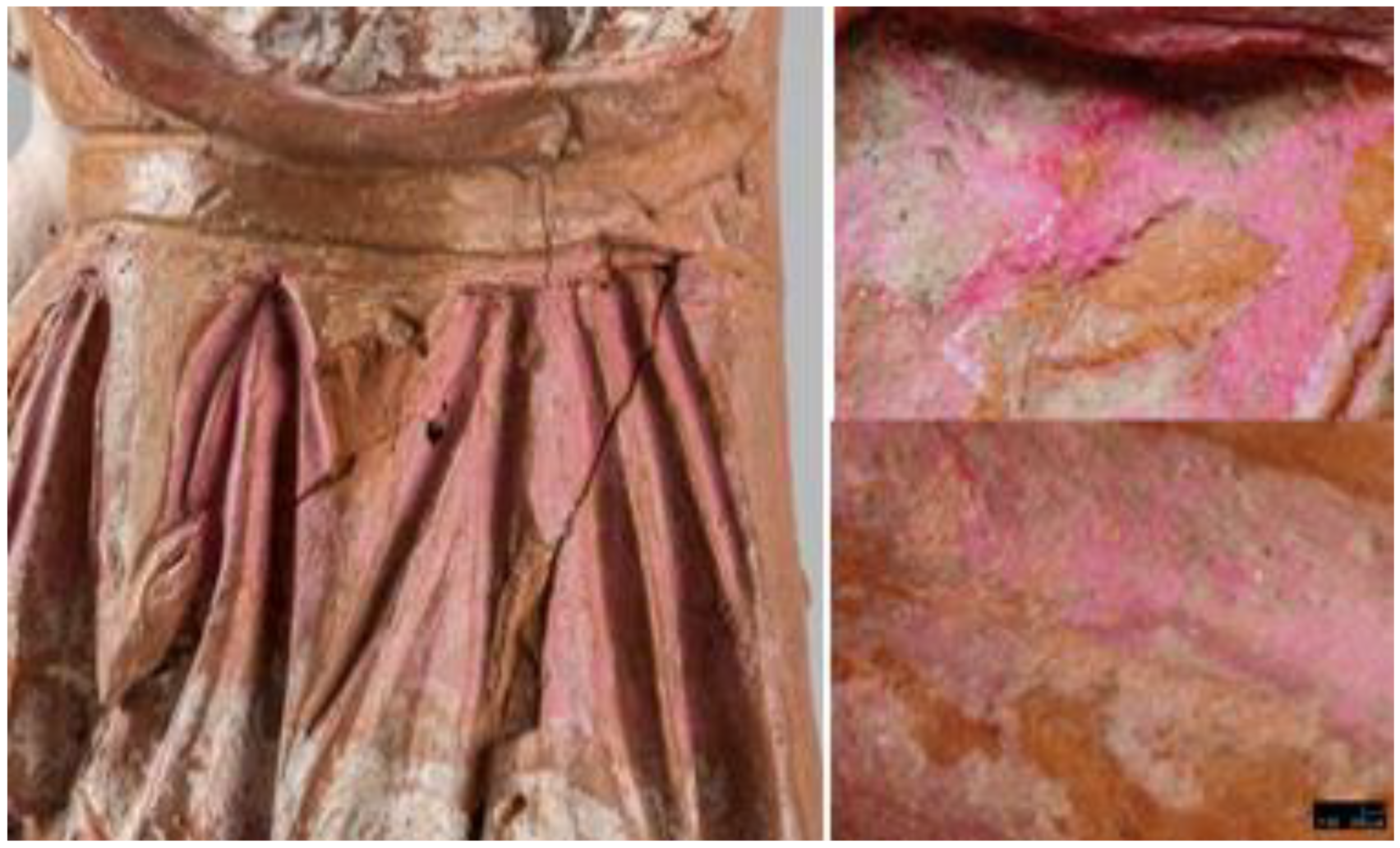
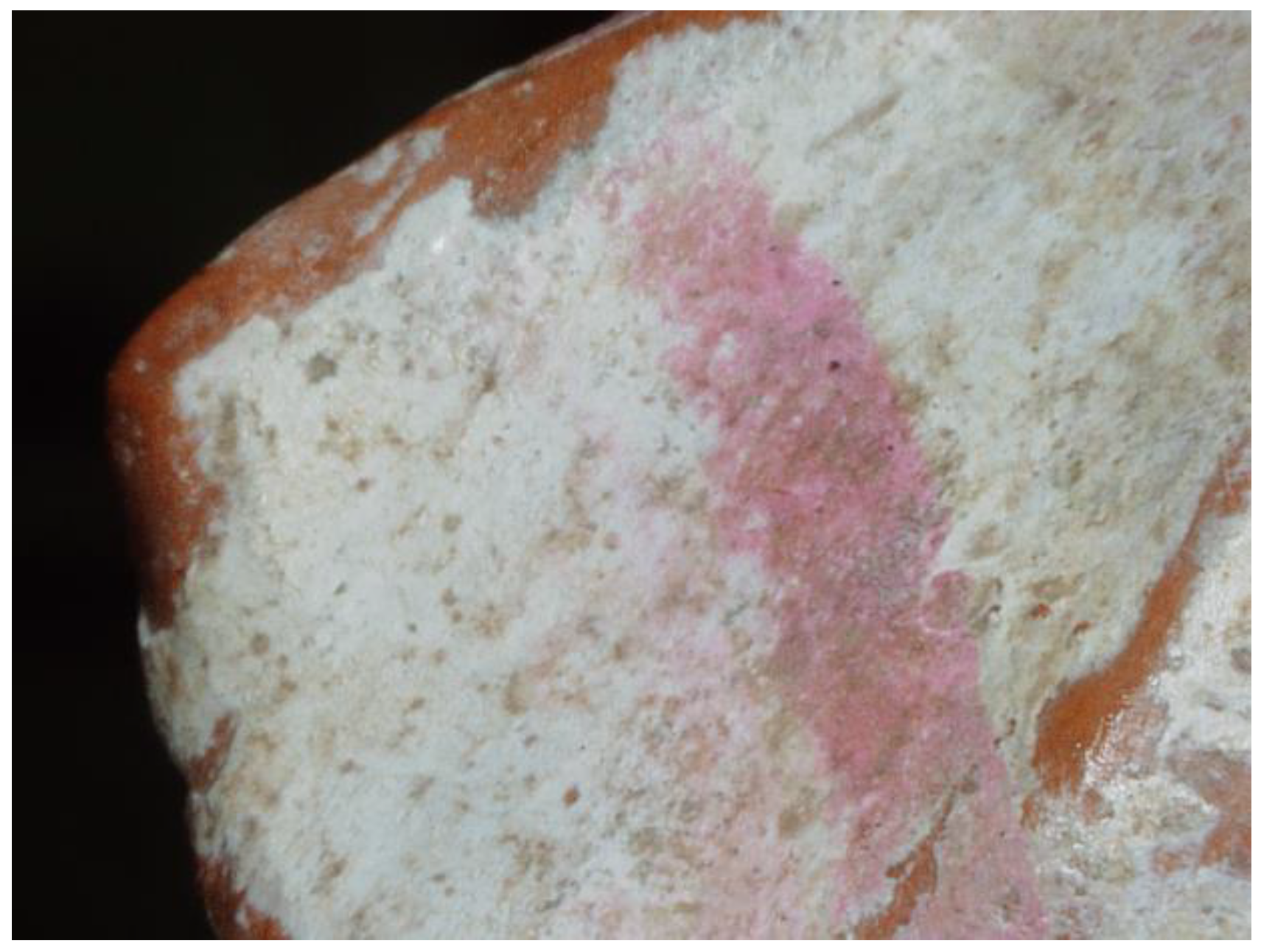
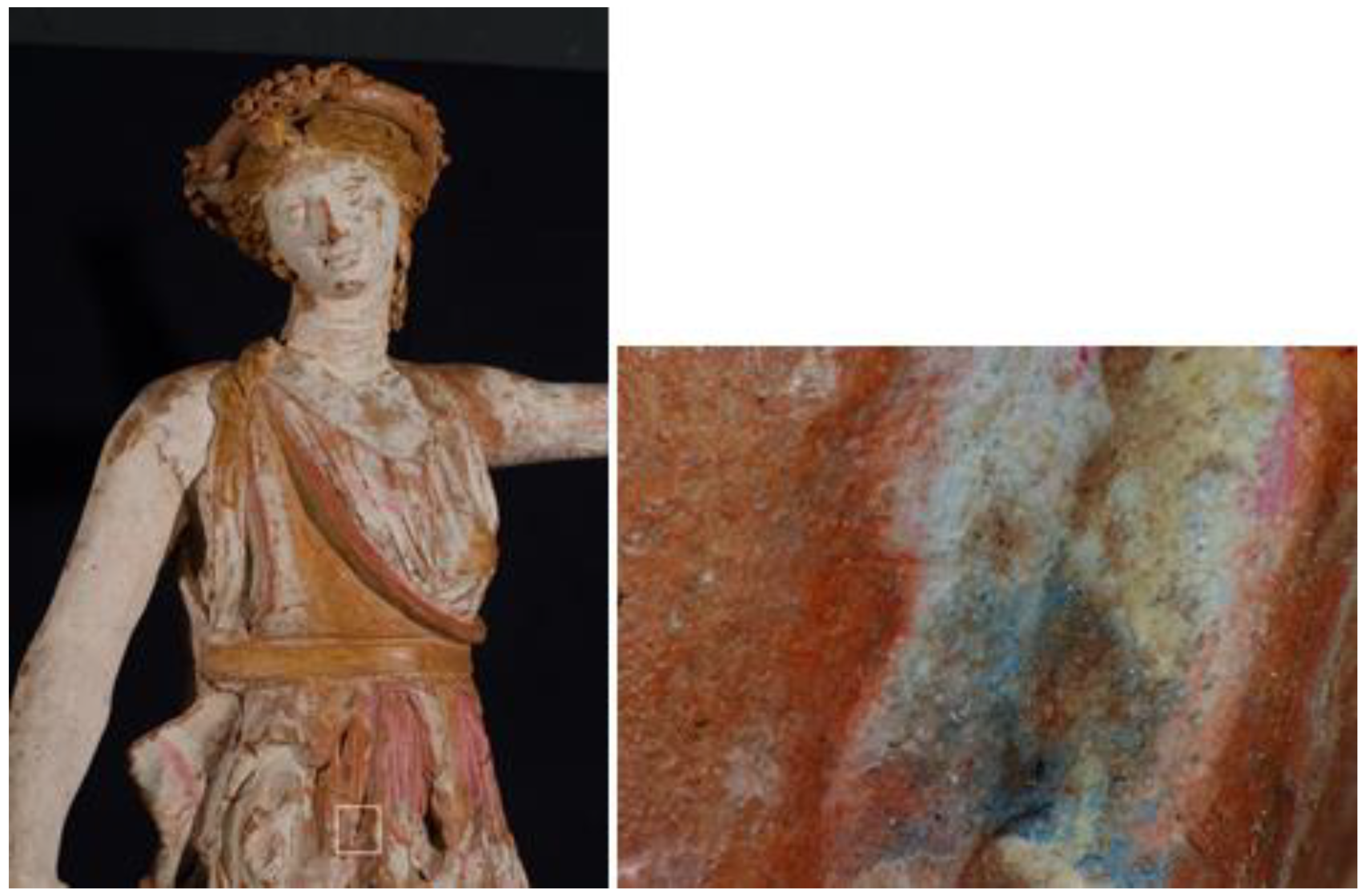
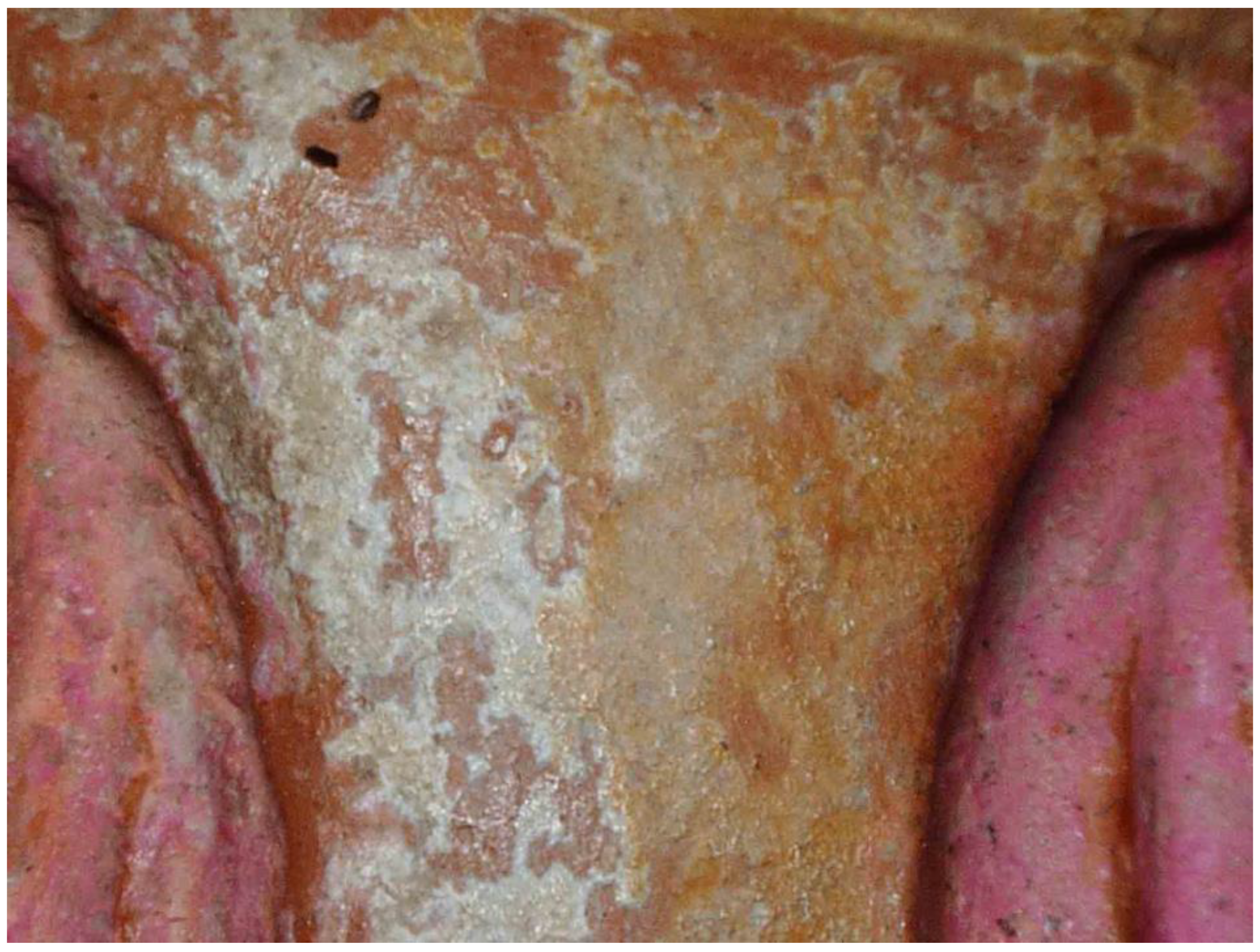
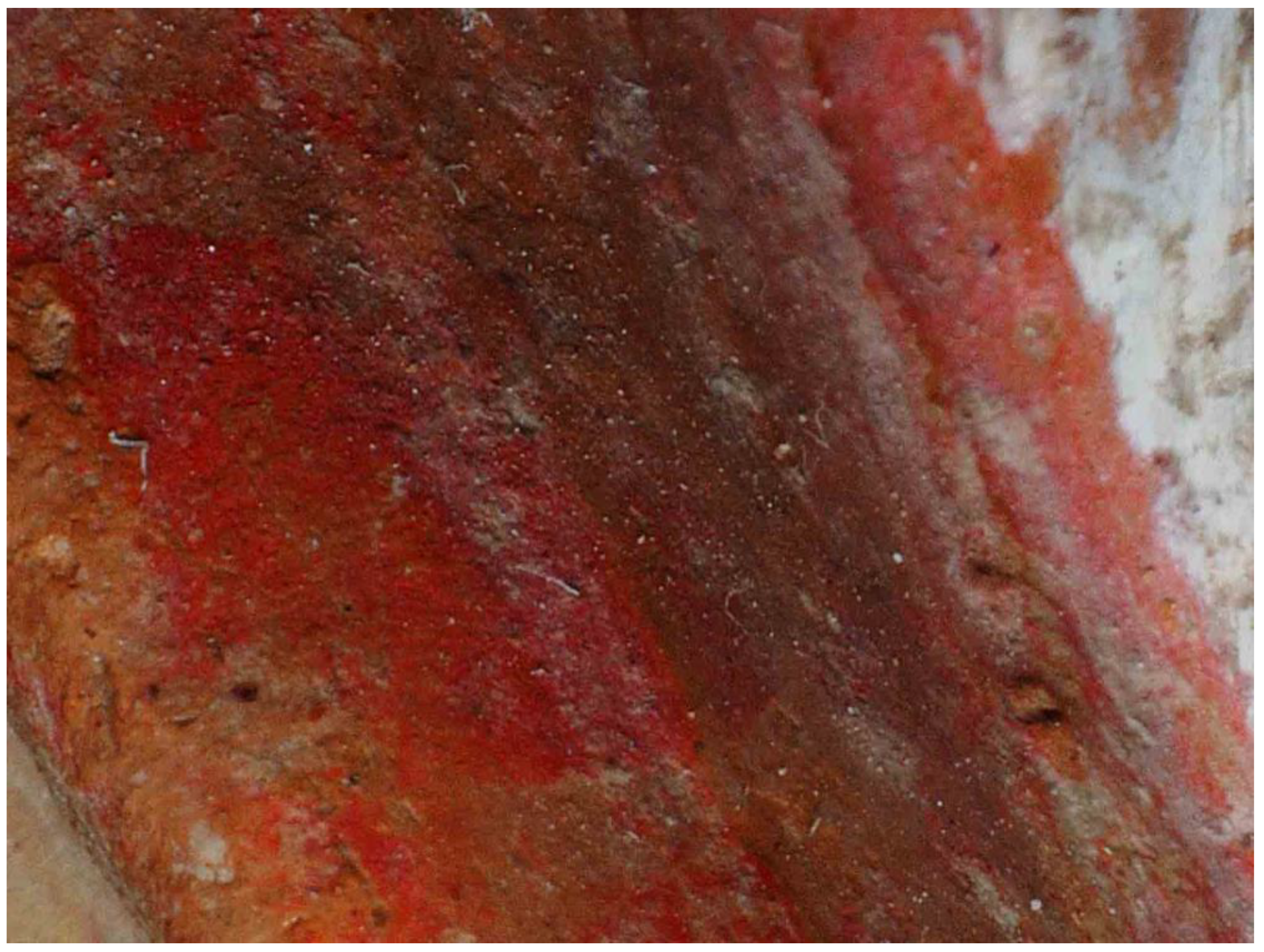
Disclaimer/Publisher’s Note: The statements, opinions and data contained in all publications are solely those of the individual author(s) and contributor(s) and not of MDPI and/or the editor(s). MDPI and/or the editor(s) disclaim responsibility for any injury to people or property resulting from any ideas, methods, instructions or products referred to in the content. |
© 2023 by the authors. Licensee MDPI, Basel, Switzerland. This article is an open access article distributed under the terms and conditions of the Creative Commons Attribution (CC BY) license (https://creativecommons.org/licenses/by/4.0/).
Share and Cite
Bourgeois, B.; Verri, G.; Jeammet, V. Color and Light: A Hellenistic Terracotta Figurine of a Maenad from Myrina. Heritage 2023, 6, 3005-3024. https://doi.org/10.3390/heritage6030160
Bourgeois B, Verri G, Jeammet V. Color and Light: A Hellenistic Terracotta Figurine of a Maenad from Myrina. Heritage. 2023; 6(3):3005-3024. https://doi.org/10.3390/heritage6030160
Chicago/Turabian StyleBourgeois, Brigitte, Giovanni Verri, and Violaine Jeammet. 2023. "Color and Light: A Hellenistic Terracotta Figurine of a Maenad from Myrina" Heritage 6, no. 3: 3005-3024. https://doi.org/10.3390/heritage6030160
APA StyleBourgeois, B., Verri, G., & Jeammet, V. (2023). Color and Light: A Hellenistic Terracotta Figurine of a Maenad from Myrina. Heritage, 6(3), 3005-3024. https://doi.org/10.3390/heritage6030160




